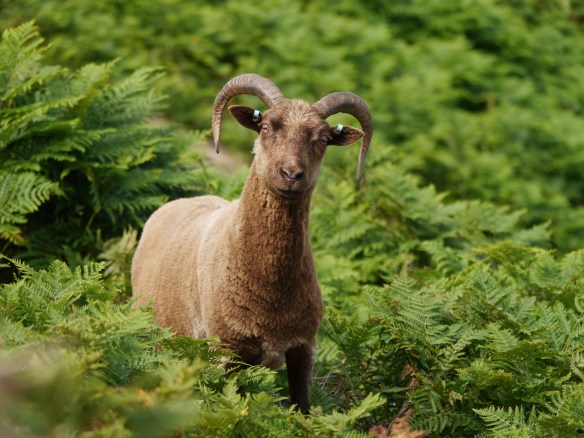By Liz Corry and Jon Rault
They might not seem like it at first glance, but the sheep at Sorel are part of a special task force deployed in Jersey to help protect and serve the Island’s biodiversity. And now to boot they have celebrity status! Having featured on BBC’s Countryfile back in summer and subsequently attracting tourists to the north coast they have once again hit the headlines with ITV Report.
The report by Katie Robinson (ITV Channel) can be found by clicking here or following The National Trust for Jersey‘s Facebook page. There is a nice video as well featuring ranger Neil Harvey and a cameo from the chough flock.
Working hard on our coastline since 2009
Having been established back in 2009 with just 20 breeding ewes and two rams, Jersey’s conservation grazing flock of Manx loaghtan sheep is now almost 200 strong. The Manx loaghtan, a hardy rare breed thought to be the closest living relative of the now extinct Jersey sheep, originate from the Isle of Man. Since their introduction, the flock have been invaluable in addressing the widespread ecological degradation that has taken place along Jersey’s north coast.
Historically, the coastal headlands and slopes on Jersey’s north coast were grazed; however changes in Jersey’s economy during the early 20th century led to the cessation of traditional mixed farming practices on marginal land. When active management ceased, the semi-natural open grassland and heathland habitats characteristic of traditionally farmed marginal areas began to be invaded by bracken and scrub. The invasion of bracken in particular, which now blankets vast swathes of land along the north coast of the Island, has sadly led to a widespread decline in biodiversity.
Reinstating active management is the key to restoring species-rich semi-natural maritime grassland and heathland habitats. The Manx loaghtan flock contribute enormously in this respect. Through the action of trampling, the sheep help to reduce the cover of bracken, while grazing controls the growth of competitive plant species, prevents scrub invasion, and facilitates the development of diverse plant communities with varied sward structures. In addition, patches of bare ground and animal dung resulting from sheep grazing provide important resources for invertebrates.
Sheep, choughs and other birds
The Manx loaghtan grazing area at Le Don Paton provides ideal habitat for the choughs. These iconic birds forage for invertebrate prey in areas of short turf and dung produced by the grazing sheep, and also use wool in nest building. In addition to benefiting Jersey’s resident wildlife, the short grassy areas maintained by grazing also provide feeding opportunities for migratory bird species of conservation concern, such as meadow pipit, wheatear and ring ouzel. 
The increase in the size of the flock is fantastic news as it will allow this highly effective and sustainable management technique to be more widely applied, facilitating the restoration of Jersey’s coastal headland habitat for the benefit of our native wildlife.
Sheep and people
The flock have proven to be extremely popular with both visitors and local residents alike, to the extent that they are now something of a visitor attraction. An additional benefit of the increase in flock size is the increased production of high quality meat for the local market, as well as wool for craft knitting.







A fabulous environmental success story which admirably endorses the word ‘national’ in Jersey’s Coastal National Park – on the cusp of an official launch in 2016.
Hear! Hear! This is all so heartening – good news amidst the all the bad.
Let’s hope that all the lessons learned here – both principles and practice – can be widely shared and employed elsewhere to equally happy effect.
I don’t doubt it – that’s one of the things that Durrell and allies do best.
Well done everyone so far – it’s very inspiring!
Very interesting. These findings agree closely with the work I did in West Wales and Cornwall (before re-establishment on the Lizard got ‘off the ground’), and also saw effectively used in Brittany.
I remember telling audiences that what Cornwall needed were three things that most farmers and conservationists instinctively felt they did NOT need: i) more rabbits, ii) more intensive sheep grazing on the cliffs, and iii) more tourists!
The latter because more feet pounding the cliff paths, headlands and cliff tops opened up the vegetation and created linear bare earth exposures (pathways) which were heavily exploited by the choughs during the early morning and evening hours when visitors tended to be tucked up in their B&Bs, campsites and hotels.
On Skomer Island, as soon as the boat arrived bringing day trippers, the choughs would simply fly down to the inaccessible cliffs (inaccessible for most humans that is) and spend the day there until the boat took them all away again. Then the choughs would return to exploit areas trampled by human feet.
One favoured site I remember was a National Trust carpark where marginal areas were used by lads on BMX bikes. Lots of lovely eroded areas through thick vegetation – perfect! Another were the Castle Martin firing ranges at Stackpole where there were many disturbed areas opened up by the West German Panzer tank divisons which trained there; the birds were not bothered at all by the military activity and took no notice of the red flags!
The best conservation does not always follow text books, although I’m not suggesting Jersey becomes a military training ground!
Really fun to read, so interesting too. I did not realize that jersey previously had its own breed of sheep